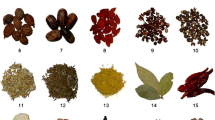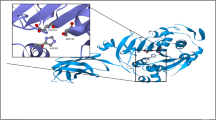Abstract
Fatty acid synthase (FAS) a racts more and more attention recently as a potential target for metabolic syndrome, such as cancer, obesity, diabetes and cerebrovascular disease. FAS inhibitors are widely existed in plants, consisting of diversiform compounds. These inhibitors exist not only in herbs also in many plant foods, such as teas, allium vegetables and some fruits. These effective components include gallated catechins, theaflavins, flavonoids, condensed and hydrolysable tannins, thioethers, pentacyclic triterpenes, stilbene derivatives, etc, and they target at the different domains of FAS, showing different inhibitory mechanisms. Interestingly, these FAS inhibitor-contained herbs and plant foods and their effective components are commonly related to the prevention of metabolic syndromes including fatreducing and depression of cancer. From biochemical angle, FAS can control the balance between energy provision and fat production. Some studies have shown that the effects of those effective components in plants on metabolic syndromes are mediated by inhibiting FAS. This suggests that FAS plays a critical role in the regulation of energy metabolism, and the FAS inhibitors from plants have significant potential application value in the treatment and prevention of metabolic syndromes.
Similar content being viewed by others
References
Goran MI, Ball GD, Cruz ML. Obesity and risk of type 2 diabetes and cardiovascular disease in children and adolescents. J Clin Endocrinol Metab 2003; 88: 1417–1427.
Calle EE, Rodriguez C, Walker-Thurmond K, et al. Overweight, obesity, and mortality from cancer in a prospectively studied cohort of U.S. adults. N Engl J Med 2003; 348: 1625–1638.
Wakil SJ: Fatty acid synthase, a proficient multifunctional enzyme. Biochemistry 1989; 28: 4523–4530.
Maier T, Leibundgut M, Ban N. The crystal structure of a mammalian fatty acid synthase. Science 2008; 321: 1315–1322.
Loftus TM, Jaworsky DE, Frehywot GL, et al. Reduced food intake and body weight in mice treated with fatty acid synthase inhibitors. Science 2000; 288: 2379–2381.
Li M, Shi Y, Tian W. Factors influencing the levels of fatty acid synthase complex activity in fowl. Biochem Mol Biol Int 1999; 47: 63–69.
Flier JS. The adipocyte: storage depot or node on the energy information superhighway? Cell 1995; 80: 15–18.
Rosen ED. Molecular mechanisms of adipocyte differentiation. Ann Endocrinol (Paris) 2002; 63: 79–82.
Schmid B, Rippmann JF, Tadayyon M, et al. Inhibition of fatty acid synthase prevents preadipocyte differentiation. Biochem Biophys Res Commun 2005; 328: 1073–1082.
Kuhajda FP. Fatty-acid synthase and human cancer: new perspectives on its role in tumor biology. Nutrition 2000; 16: 202–208.
Vance D, Goldberg I, Mitsuhashi O, et al. Inhibition of fatty acid synthetases by the antibiotic cerulenin. Biochem Biophys Res Commun 1972; 48: 649–656.
Kuhajda FP, Pizer ES, Li JN, et al. Synthesis and antitumor activity of an inhibitor of fatty acid synthase. Proc Natl Acad Sci USA 2000; 97: 3450–3454.
Wang X, Tian W. Green tea epigallocatechin gallate: a natural inhibitor of fatty-acid synthase. Biochem Biophys Res Commun 2001; 288: 1200–1206.
Kao YH, Hiipakka RA, Liao S. Modulation of endocrine systems and food intake by green tea epigallocatechin gallate. Endocrinology 2000; 141: 980–987.
Wang X, Song KS, Guo QX, et al. The galloyl moiety of green tea catechins is the critical structural feature to inhibit fatty-acid synthase. Biochem Pharmacol 2003; 66: 2039–2047.
Zhang R, Xiao W, Tian W. Inhibitory effect of green tea extract on fatty acid synthase. Journal of Yunnan University (natural sciences) 2004; 26: 42–47 (Chinese).
Zhang R, Xiao W, Wang X, et al: Novel inhibitors of fatty-acid synthase from green tea (Camellia sinensis Xihu Longjing) with high activity and a new reacting site. Biotechnol Appl Biochem 2006; 43: 1–7.
Du YT, Wang X, Wu XD, et al. Keemun black tea extract contains potent fatty acid synthase inhibitors and reduces food intake and body weight of rats via oral administration. J Enzyme Inhib Med Chem 2005; 20: 349–356.
Jiang B, Tian W, WU X. Inhibitory effect of Sichuan Bian Tea on fatty acid synthase. Journal of Graduate University of Chinese Academy of Sciences 2007; 24: 291–299 (Chinese).
Wang Y, Zhang SY, Ma XF, et al. Potent inhibition of fatty acid synthase by parasitic loranthus [Taxillus chinensis (dc.) danser] and its constituent avicularin. J Enzyme Inhib Med Chem 2006; 21: 87–93.
Li L, Wu X, Tian W. Inhibitory effect of polygonum multiflorum extract on fatty acid synthase. Journal of Graduate Univsersity of Chinese Academy of Sciences 2003; 19: 133–140 (Chinese).
Li BH, Tian WX. Presence of fatty acid synthase inhibitors in the rhizome of Alpinia officinarum hance. J Enzyme Inhib Med Chem 2003; 18: 349–356.
Cheng Q, Huang H, Fan F, et al. Inhibitory effect of ginkgo leaf extract on fatty acid synthase. Natural product application and development 2009; 19: 181–187.
Sun Y, Zhang R, Zhang S, et al. Night kodo extract inhibits fatty acid synthase and reduces the bodyweight and appetite of mice and rats. Journal of Graduate University of Chinese Academy of Sciences 2007; 24: 453–459 (Chinese).
Zhao WH, Gao C, Zhang YX, et al. Evaluation of the inhibitory activities of aceraceous plants on fatty acid synthase. J Enzyme Inhib Med Chem 2007; 22: 501–510.
Duthie GG, Duthie SJ, Kyle JA. Plant polyphenols in cancer and heart disease: implications as nutritional antioxidants. Nutr Res Rev 2000; 13: 79–106.
Li BH, Tian WX. Inhibitory effects of flavonoids on animal fatty acid synthase. J Biochem 2004; 135: 85–91.
Li BH, Ma XF, Wang Y, et al. Structure-activity relationship of polyphenols that inhibit fatty acid synthase. J Biochem 2005; 138: 679–685.
Tian WX. Inhibition of fatty acid synthase by polyphenols. Curr Med Chem 2006; 13: 967–977.
Kuda T, Iwai A, Yano T. Effect of red pepper Capsicum annuum var. conoides and garlic Allium sativum on plasma lipid levels and cecal microflora in mice fed beef tallow. Food Chem Toxicol 2004; 42: 1695–1700.
Gabler NK, Osrowska E, Imsic M, et al. Dietary onion intake as part of a typical high fat diet improves indices of cardiovascular health using the mixed sex pig model. Plant Foods Hum Nutr 2006; 61: 179–185.
Tache S, Ladam A, Corpet DE. Chemoprevention of aberrant crypt foci in the colon of rats by dietary onion. Eur J Cancer 2007; 43: 454–458.
Hughes J, Tregova A, Tomsett AB, et al. Synthesis of the flavour precursor, alliin, in garlic tissue cultures. Phytochemistry 2005; 66: 187–194.
Sun XB, Tian WX. Inhibitory Effects of Allium Vegetable Extracts on Fatty Acid Synthase. Food Science and Technology Research 2009; 3: 343–346 (Chinese).
Sun XB, Zhao J, Ma XF, et al. Inhibitory effects of thioethers on fatty acid synthase and 3T3-L1 cells. J Enzyme Inhib Med Chem 2010; 25: 290–295.
Zhang SY, Zheng CG, Yan XY, et al. Low concentration of condensed tannins from catechu significantly inhibits fatty acid synthase and growth of MCF-7 cells. Biochem Biophys Res Commun 2008; 371: 654–658.
Somova LO, Nadar A, Rammanan P, et al. Cardiovascular, antihyperlipidemic and antioxidant effects of oleanolic and ursolic acids in experimental hypertension. Phytomedicine 2003; 10: 115–121.
Jang SM, Yee ST, Choi J, et al. Ursolic acid enhances the cellular immune system and pancreatic betacell function in streptozotocin-induced diabetic mice fed a high-fat diet. Int Immunopharmacol 2009; 9: 113–119.
Dorai T, Aggarwal BB. Role of chemopreventive agents in cancer therapy. Cancer Lett 2004; 215: 129–140.
Safayhi H, Sailer ER. Anti-inflammatory actions of pentacyclic triterpenes. Planta Med 1997; 63: 487–493.
Liu Y, Tian W, Ma X, et al. Evaluation of inhibition of fatty acid synthase by ursolic acid: positive cooperation mechanism. Biochem Biophys Res Commun 2010; 392: 386–390.
Li BH, Ma XF, Wu XD, et al. Inhibitory activity of chlorogenic acid on enzymes involved in the fatty acid synthesis in animals and bacteria. IUBMB Life 2006; 58: 39–46.
Liang Y, Tian W, Ma X. Chemical components of Polygonum multiflorum Thunb. Journal of Shenyang Pharmaceutical University 2009; 26: 536–538 (Chinese).
Liang Y, Ma X, Tian W. Natural fatty acid synthase inhibitors from grape. 1st International Symposium on Edible Plant Resources and the Bioactive Ingredients. Urumchi China 2008; 213 (Chinese).
Clarke SD, Armstrong MK, Jump DB: Nutritional control of rat liver fatty acid synthase and S14 mRNA abundance. J Nutr 1990; 120: 218–224.
Friedman JM: Obesity in the new millennium. Nature 2000; 404: 632–634.
Tian W, Dong Y, Quan H, et al. The dependence of fat level of Hen on activity of fatty acid synthase in liver on different ages. Chinese Biochemistry Journal 1996; 12: 234–236 (Chinese).
Cairns RA, Harris IS, Mak TW. Regulation of cancer cell metabolism. Nat Rev Cancer 2011; 11: 85–95.
Author information
Authors and Affiliations
Corresponding author
About this article
Cite this article
Tian, Wx., Ma, Xf., Zhang, Sy. et al. Fatty acid synthase inhibitors from plants and their potential application in the prevention of metabolic syndrome. Clin. Oncol. Cancer Res. 8, 1–9 (2011). https://doi.org/10.1007/s11805-011-0550-3
Received:
Accepted:
Published:
Issue Date:
DOI: https://doi.org/10.1007/s11805-011-0550-3




